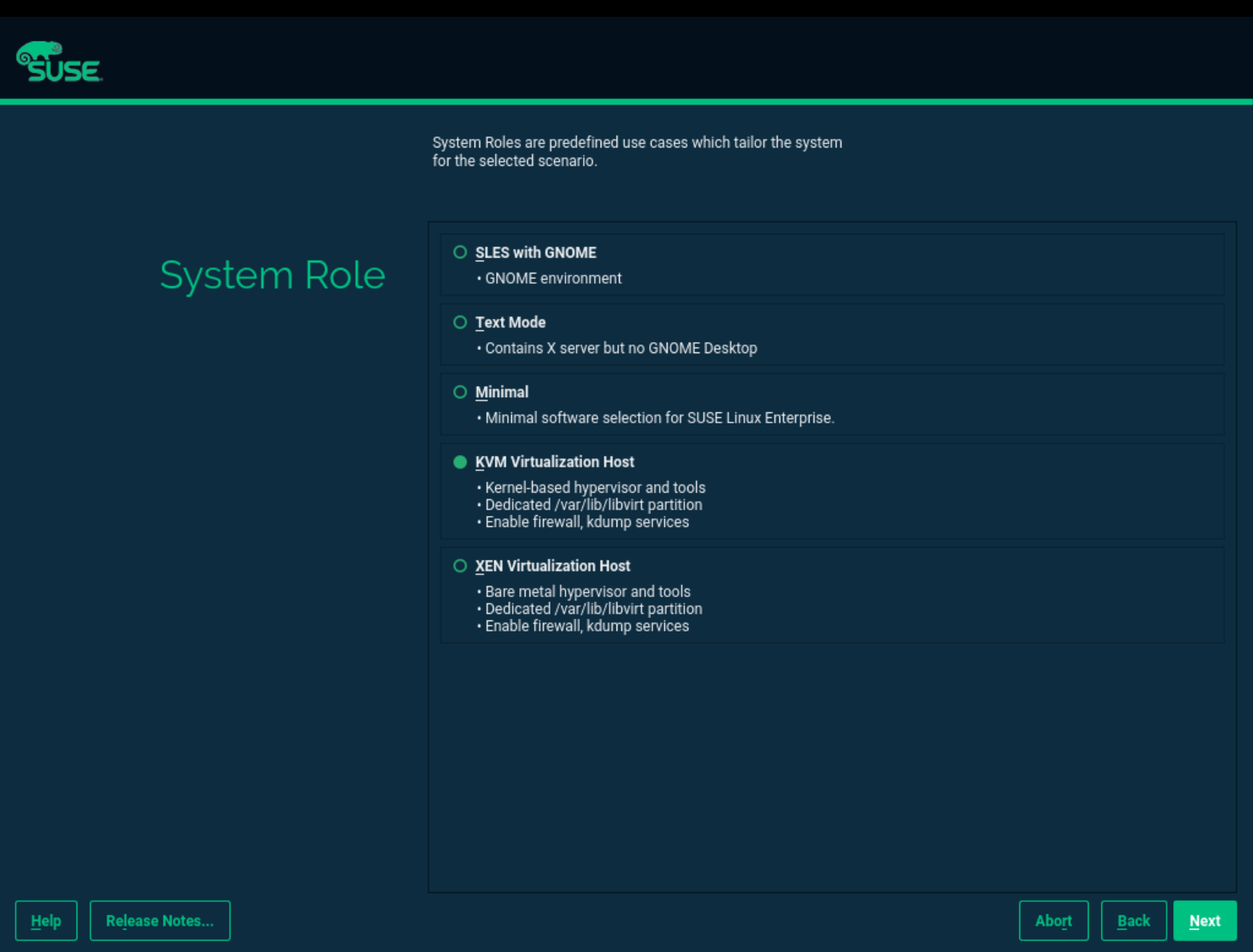Installing Virtualization Components
- WHAT?
A virtualization host needs tools to provide virtualization services to guest systems.
- WHY?
You want to configure a host to run multiple virtualized guest systems under a preferred hypervisor.
- EFFORT
Less that 10 minutes is enough to study and install needed virtualization components.
- GOAL
You can turn a SLES host system into a virtualization host easily.
- REQUIREMENTS
A bare-metal host that complies with minimal hardware requirements for SLES.
1 Introduction #
To run a virtualization server (VM Host Server) that can host multiple guest systems (VM Guests), you need to install required virtualization components on the server. These components vary depending on which virtualization technology you want to use.
You can install the virtualization tools required to run a VM Host Server in one of the following ways:
By selecting a specific system role during a SUSE Linux Enterprise Server installation on the VM Host Server
By installing specific installation patterns on an already installed SUSE Linux Enterprise Server host
By running the YaST Virtualization module on an already installed SUSE Linux Enterprise Server host
2 Specifying a system role #
This topic describes how to install virtualization components by specifying a system role during the SLES installation.
Start the SLES installation and follow the instructions until you reach the screen.
Figure 1: System Role screen #On the screen, select either the or the role. The appropriate software selection and setup are automatically performed during the SUSE Linux Enterprise Server installation.
ImportantBoth virtualization system roles create a dedicated
/var/lib/libvirtpartition and enable thefirewalldand Kdump services.
3 Specifying installation patterns #
Related software packages from SUSE Linux Enterprise Server software repositories are
organized into installation patterns. You can use these
patterns to install specific virtualization components on an already running
SUSE Linux Enterprise Server system. Use zypper to install the patterns, for
example:
>sudozypper install -t pattern kvm_server
kvm_serverInstalls a basic VM Host Server with the KVM and QEMU environments.
kvm_toolsInstalls
libvirttools for managing and monitoring VM Guests in the KVM environment.xen_serverInstalls a basic Xen VM Host Server.
xen_toolsInstalls
libvirttools for managing and monitoring VM Guests in the Xen environment.
4 Using the YaST virtualization module #
This topic describes how to install virtualization components on an already installed SLES system using YaST.
The YaST Virtualization module is included in the yast2-vm package. Verify it is installed on the VM Host Server before installing virtualization components.
Start YaST and select › .
Select for a minimal installation of the QEMU and KVM environment. To use the
libvirt-based management stack with KVM as well, select .Select for a minimal installation of the Xen environment. To use the
libvirt-based management stack with Xen as well, select .
YaST offers to automatically configure a network bridge on the VM Host Server. It ensures proper networking capabilities of the VM Guest. Agree to do so by selecting , otherwise choose .
After the setup has been finished, you can start creating and configuring VM Guests. Rebooting the VM Host Server is not required.
5 Legal Notice #
Copyright© 2006–2026 SUSE LLC and contributors. All rights reserved.
Permission is granted to copy, distribute and/or modify this document under the terms of the GNU Free Documentation License, Version 1.2 or (at your option) version 1.3; with the Invariant Section being this copyright notice and license. A copy of the license version 1.2 is included in the section entitled “GNU Free Documentation License”.
For SUSE trademarks, see https://www.suse.com/company/legal/. All other third-party trademarks are the property of their respective owners. Trademark symbols (®, ™ etc.) denote trademarks of SUSE and its affiliates. Asterisks (*) denote third-party trademarks.
All information found in this book has been compiled with utmost attention to detail. However, this does not guarantee complete accuracy. Neither SUSE LLC, its affiliates, the authors, nor the translators shall be held liable for possible errors or the consequences thereof.
